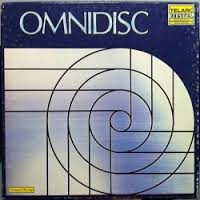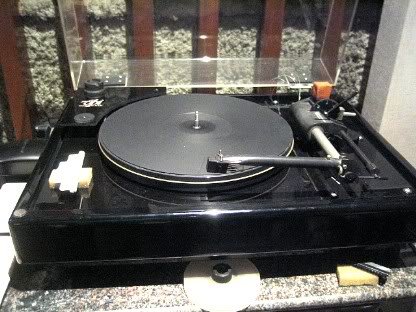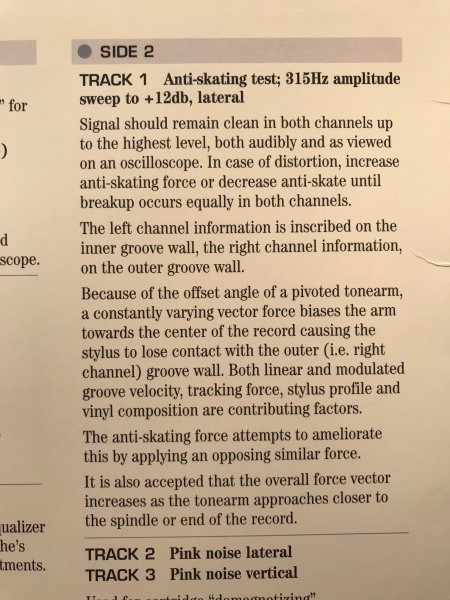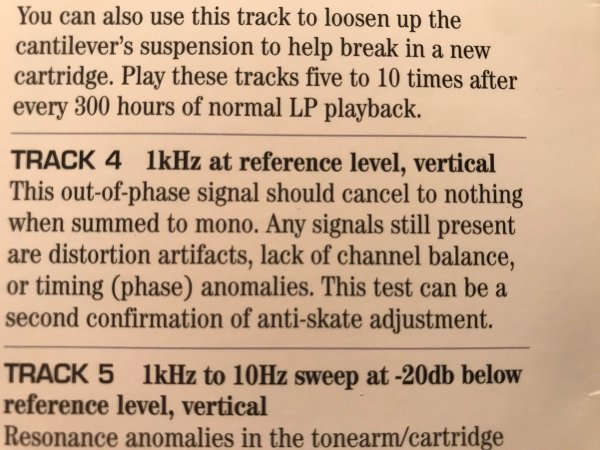Curious to see what you hear, Phil. Are there any test records with anti-skate test tracks, and what kind of test would that be...
Sliding force???
- Thread starter ack
- Start date
You are using an out of date browser. It may not display this or other websites correctly.
You should upgrade or use an alternative browser.
You should upgrade or use an alternative browser.
Curious to see what you hear, Phil. Are there any test records with anti-skate test tracks, and what kind of test would that be...
Tasos, I mainly used non-test LPs for listening. Like for female vocals, I used the Doris Day Latin for Lovers Columbia LP and for instruments I used the Tango LP of Charlie Byrd and Laurindo Almeida. In both, I hear more body, in the voice and in the guitars with the 1.8 anti skating bias although this setting gives a light inward bend to the cantilever. At 0 bias, the overall sound, from imagine, separation of instruments, and balance, top to bottom frequencies, and left to right balance seems to fall in the proper places, it's like magic to me. But sadly, to me taste, it does sound 'leaner', instruments and voices.
I have many test LPs from the past, using music selections, but they are not as noticeable so I use records that I have used as references to test anything in the audio chain. An EMI and Nautilus test record have blank cuts which they call the anti-skate test, which I now find out is not accurate.
This is a bit of a long read, from an FB Koetsu User Group member, who sort of opened my eyes re this controversial subject:
"So much rubbish has been written on this subject. What follows is not anything I've read but what seems obvious to me from an engineering perspective.
1. Anti skate? What is skate? The tendency for the stylus to head (skate) for the spindle when covered in fluff and out of the groove? Or in the case of a blank disc the stylus's inclination to do the same? Why oh why do people assume that the same dynamics apply to the stylus whilst in the groove to when floating freely? They don't! When the stylus is on a blank rotating surface then the drag of the vinyl will drag it in (out if spun anticlockwise) but when in the groove it is held solidly in position as in a train on a track! (Now let's not over think this people, remember that in this instance it's the track that's moving, not the train, so please don't associate inertial forces as they don't apply here) So anyone who tells you to set bias so that the stylus is stationary when in blank rotating vinyl just ain't getting it! All that will do is make the stylus attempt to ride the outer wall of the groove and climb up it. Have you ever noticed how some records stick? That's usually excessive bias causing the stylus to climb the outer groove wall (in conjunction with a scratch or dust etc) Ok, so skate (when we're in the groove) doesn't exist. So why try to compensate for something that doesn't exist. Don't apply bias!
2. The belief that benefit is attained by applying force laterally in terms of tracking!?!? That one really seems weird to me? Left and right tracking are directly opposing forces. All you need is the correct downforce, ie, tracking weight and left channel/ right channel will be dead equal ( remember it's the track that's moving, not the train!) If any cartridge manufacturer has engineered extra stiffness in the suspension in one lateral direction only to allow for 2 grams of side force it's news to me. To give a better explanation I'd need to give illustrations/ diagrams etc. If you Google images of a stylus in a groove it should help. I very rarely set any bias. When I do it's extremely minimal (and even then I'm not exactly sure why I'm doing it tbh) "
He follows it up...
"The behaviour on the stylus on a blank disc is utterly irrelevant, of that I am sure. If one is too assume that Sugano knew what he was doing then his Koetsu arm (SA1100D) designed by him but built by Jelco was the only ever Jelco built arm with no bias setting. Sugano specified no bias. Note I just stated 'on' a blank disc? This is opposed to 'in' a groove where the dynamics are utterly different. Over many years I've had quite a fetish for turntables/tonearms and especially cartridges. I have 100's of them dating back to the 1930's. I also have a microscope that I have used for evaluation of stylus wear. I noticed many years ago that 90% of stylus wear that I have observed is on the side of the stylus that faces the outer groove. In many cases the profile that faces the inner groove is almost untouched. The reason for this is obvious. Too much bias. The stylus sits in a groove, the tip of the stylus does not reach the bottom of the groove. It is required that the pressure of the stylus is equal in the groove, not in the case of bias set; pressing against the outer groove.
As I've already said, any cartridge returned from The Expert Stylus Co will have a covering letter asking you to never apply bias with along with a brief explanation. From my own observations I have experimented with the application of bias, so, in the case of Koetsu (I'm using Koetsu because it's a class leader in terms of soundstage) if I apply bias it just sounds instantly wrong (strained) the normally relaxed even layout of the orchestra sounds sort of twisted (I'm struggling in exactly how to describe this but it sounds wrong) when I return to zero bias everything drops back into place and sounds natural and relaxed. I guess the stylus needs to have equal pressure either side to get accurate left to right information, it's impossible for me to believe anything else.
I have however found that in the case of very high compliance cartridges, ie, Shure V15's Grace and early ADC cartridges (especially the 26) that, when used in SME 2 (& more particularly 3) series arms, that, if tracking below 1 gram ( as per the recommendation of the day) that a tiny bit of bias does indeed help secure tracking. Although I'm not completely sure I'd guess that in this case the down force is so low that although theoretically able to track that in real world conditions 0.75 of a gram can't even push the dust out the way let alone handle dynamics/transients etc.
As I've said I'm not sure why but bias (at the smallest setting appears to help) In the case of the Koetsu this is not the case. The Koetsu we have low compliance. If the tonearm is suited to the Koetsu, ie, high mass, high integrity radial bearings. Also the stylus pressure should be set to 2 grams (I often set 2.05 grams) then, the stylus should be utterly secure in the groove and require no bias setting whatsoever. IMHO"
"So much rubbish has been written on this subject. What follows is not anything I've read but what seems obvious to me from an engineering perspective.
1. Anti skate? What is skate? The tendency for the stylus to head (skate) for the spindle when covered in fluff and out of the groove? Or in the case of a blank disc the stylus's inclination to do the same? Why oh why do people assume that the same dynamics apply to the stylus whilst in the groove to when floating freely? They don't! When the stylus is on a blank rotating surface then the drag of the vinyl will drag it in (out if spun anticlockwise) but when in the groove it is held solidly in position as in a train on a track! (Now let's not over think this people, remember that in this instance it's the track that's moving, not the train, so please don't associate inertial forces as they don't apply here) So anyone who tells you to set bias so that the stylus is stationary when in blank rotating vinyl just ain't getting it! All that will do is make the stylus attempt to ride the outer wall of the groove and climb up it. Have you ever noticed how some records stick? That's usually excessive bias causing the stylus to climb the outer groove wall (in conjunction with a scratch or dust etc) Ok, so skate (when we're in the groove) doesn't exist. So why try to compensate for something that doesn't exist. Don't apply bias!
2. The belief that benefit is attained by applying force laterally in terms of tracking!?!? That one really seems weird to me? Left and right tracking are directly opposing forces. All you need is the correct downforce, ie, tracking weight and left channel/ right channel will be dead equal ( remember it's the track that's moving, not the train!) If any cartridge manufacturer has engineered extra stiffness in the suspension in one lateral direction only to allow for 2 grams of side force it's news to me. To give a better explanation I'd need to give illustrations/ diagrams etc. If you Google images of a stylus in a groove it should help. I very rarely set any bias. When I do it's extremely minimal (and even then I'm not exactly sure why I'm doing it tbh) "
He follows it up...
"The behaviour on the stylus on a blank disc is utterly irrelevant, of that I am sure. If one is too assume that Sugano knew what he was doing then his Koetsu arm (SA1100D) designed by him but built by Jelco was the only ever Jelco built arm with no bias setting. Sugano specified no bias. Note I just stated 'on' a blank disc? This is opposed to 'in' a groove where the dynamics are utterly different. Over many years I've had quite a fetish for turntables/tonearms and especially cartridges. I have 100's of them dating back to the 1930's. I also have a microscope that I have used for evaluation of stylus wear. I noticed many years ago that 90% of stylus wear that I have observed is on the side of the stylus that faces the outer groove. In many cases the profile that faces the inner groove is almost untouched. The reason for this is obvious. Too much bias. The stylus sits in a groove, the tip of the stylus does not reach the bottom of the groove. It is required that the pressure of the stylus is equal in the groove, not in the case of bias set; pressing against the outer groove.
As I've already said, any cartridge returned from The Expert Stylus Co will have a covering letter asking you to never apply bias with along with a brief explanation. From my own observations I have experimented with the application of bias, so, in the case of Koetsu (I'm using Koetsu because it's a class leader in terms of soundstage) if I apply bias it just sounds instantly wrong (strained) the normally relaxed even layout of the orchestra sounds sort of twisted (I'm struggling in exactly how to describe this but it sounds wrong) when I return to zero bias everything drops back into place and sounds natural and relaxed. I guess the stylus needs to have equal pressure either side to get accurate left to right information, it's impossible for me to believe anything else.
I have however found that in the case of very high compliance cartridges, ie, Shure V15's Grace and early ADC cartridges (especially the 26) that, when used in SME 2 (& more particularly 3) series arms, that, if tracking below 1 gram ( as per the recommendation of the day) that a tiny bit of bias does indeed help secure tracking. Although I'm not completely sure I'd guess that in this case the down force is so low that although theoretically able to track that in real world conditions 0.75 of a gram can't even push the dust out the way let alone handle dynamics/transients etc.
As I've said I'm not sure why but bias (at the smallest setting appears to help) In the case of the Koetsu this is not the case. The Koetsu we have low compliance. If the tonearm is suited to the Koetsu, ie, high mass, high integrity radial bearings. Also the stylus pressure should be set to 2 grams (I often set 2.05 grams) then, the stylus should be utterly secure in the groove and require no bias setting whatsoever. IMHO"
Thanks. Regarding his point #1, this is why I called the thread "sliding force" rather than "skating force" - they are indeed different. And we now all agree that setting anti-skating by using the sliding force is not correct.
Regarding test records, I was hoping to find one that would let me measure something, not just play music.
Regarding his last point that Koetsus do not require such bias, I wouldn't know, but it's interesting that you seem to lean on at least some, to address the lean sound you are hearing.
Regarding sound "effects" of anti-skating, I would point you to the Amanda McBroom Growing Up in Hollywood, which we both liked listening to in here, years ago when you visited. With some bias, instruments on the right channel are far clearer - for example, the guitar on track 1 - and this is the first thing that jumped out on me at first. Since then, all kinds of things are so much clearer on the same right channel, when using some bias, and now with less distortion all around.
PS: Where is Myles when you really need him, to enlighten us
Regarding test records, I was hoping to find one that would let me measure something, not just play music.
Regarding his last point that Koetsus do not require such bias, I wouldn't know, but it's interesting that you seem to lean on at least some, to address the lean sound you are hearing.
Regarding sound "effects" of anti-skating, I would point you to the Amanda McBroom Growing Up in Hollywood, which we both liked listening to in here, years ago when you visited. With some bias, instruments on the right channel are far clearer - for example, the guitar on track 1 - and this is the first thing that jumped out on me at first. Since then, all kinds of things are so much clearer on the same right channel, when using some bias, and now with less distortion all around.
PS: Where is Myles when you really need him, to enlighten us
Thanks. Regarding his point #1, this is why I called the thread "sliding force" rather than "skating force" - they are indeed different. And we now all agree that setting anti-skating by using the sliding force is not correct.
Regarding test records, I was hoping to find one that would let me measure something, not just play music.
Regarding his last point that Koetsus do not require such bias, I wouldn't know, but it's interesting that you seem to lean on at least some, to address the lean sound you are hearing.
Regarding sound "effects" of anti-skating, I would point you to the Amanda McBroom Growing Up in Hollywood, which we both liked listening to in here, years ago when you visited. With some bias, instruments on the right channel are far clearer - for example, the guitar on track 1 - and this is the first thing that jumped out on me at first. Since then, all kinds of things are so much clearer on the same right channel, when using some bias, and now with less distortion all around.
PS: Where is Myles when you really need him, to enlighten us
Good point, on the term 'sliding force'. I am indeed learning something new each day on this topic.
From what I gathered, the Hi Fi News Test Record has modulated tracks that lets you zero in on the left and right grooves by adjusting the anti-skate dial or mechanism.
And I think I will be experimenting on adding little bias slowly to hear the 'improvements', particularly more 'body' to the vocals and instruments. I was able to find a picture of the first Koetsu tonearm and indeed it had no anti skate dial, while the succeeding models up the MKVI had such a dial. Well, it is better to be there when it's needed, I guess. And when not, just set it to 0.
That's good to know, re the Amanda The Portrait cut. I will watch out for that in my future tests. And I have learned too, that the groove wall that is nearer the tonearm is the Right channel, so adding a little force does make the stylus lean more on the right channel groove.
And since you are using a VPI tonearm, you must have known that VPI from the outset did not have an anti-skate mechanism, but later on provided it as an after sales accessory. I have heard this long ago from a friend but since I had no anti skate concern with my ET2 then, it was not relevant to me. From this site that sells this device, it is noted...
"Arm manufacturers have tried to compensate for this force, but that is impossible because the force is constantly changing as the music and velocity change.
VPI has conducted careful listening tests and determined that every tonearm they tried sounded better with its mechanical anti-skating disabled and the tracking force very slightly increased... "
http://www.elusivedisc.com/VPI-Anti-Skate-Device-for-JMW-9-Tonearms/productinfo/VPI-D1013/
So with this device, the user has a choice.
"Arm manufacturers have tried to compensate for this force, but that is impossible because the force is constantly changing as the music and velocity change.
VPI has conducted careful listening tests and determined that every tonearm they tried sounded better with its mechanical anti-skating disabled and the tracking force very slightly increased... "
http://www.elusivedisc.com/VPI-Anti-Skate-Device-for-JMW-9-Tonearms/productinfo/VPI-D1013/
So with this device, the user has a choice.
Yes, I am aware of VPI's position, which is reason enough to investigate further.
It is now intriguing to me, this phenomenon.
i am finding this thread very interesting. Maybe table leveling and proper alignment setup tracking force, overhang is more critical than skating force. I tried it on my 1200G and I actually seem to like it better with no skating force so far.
(...) "Arm manufacturers have tried to compensate for this force, but that is impossible because the force is constantly changing as the music and velocity change. (...)
This only means that the force can not be fully compensated, but only partially - they apply an average value. And most people will still believe that partially compensated is better than a fully acting lateral force.
IMHO basic physics clearly explains why the force exists in pivot tonearms. If people prefer to avoid using the anti- skating mechanism they must explain why or simply say they prefer the sound with it.
There is some strength in the argument that linear arms reproduce better the conditions of the cutter.
i am finding this thread very interesting. Maybe table leveling and proper alignment setup tracking force, overhang is more critical than skating force. I tried it on my 1200G and I actually seem to like it better with no skating force so far.
I believe this is exactly right - tracking force, alignment/ and overhang are the most critical (much more) than anti-skate (I'll stick with the traditional verbiage.) Add azimuth to that list. Zero or no anti-skate is my default for starting with a new or re-mounted cartridge. This does not mean anti-skate should be neglected. A stylus losing contact with the groove due to complex groove modulations can damage the vinyl.
If there are issues with anti-skate they will make themselves audibly known. As mentioned in kodomo's opus-1 thread, strongly dynamic upper-mid to treble notes closer to the run-out area is sometimes where anti-skate based groove distortion appears.
Are there any test records with anti-skate test tracks, and what kind of test would that be...
Yes. The Telarc OmniDisc set of test records includes a band for tracking force and anti-skating force.

Telarc DG-10073/74
But before you buy a test record, consider that anti-skate related distortion is often learly audible. Distortion in the right channel usually means too little anti-skate and left channel distortion means too much anti-skate. The distortion sounds can range from an intermitant buzzing to an obvious break-up of the sound, as if the stylus is coming into contact then losing contact with the groove - which it is.
'
Hope to hear your test results, Tasos.
Well, I just realized that the Analogue Productions Ultimate Analogue Test LP that I've been using for years does have two anti-skate test tracks:
View attachment 56028
View attachment 56029
Hope to hear your test results, Tasos.
This only means that the force can not be fully compensated, but only partially - they apply an average value. And most people will still believe that partially compensated is better than a fully acting lateral force.
IMHO basic physics clearly explains why the force exists in pivot tonearms. If people prefer to avoid using the anti- skating mechanism they must explain why or simply say they prefer the sound with it.
There is some strength in the argument that linear arms reproduce better the conditions of the cutter.
How I miss my air bearing linear tracker now. Used it for 26 years till wear and tear took its toll.

'
Hope to hear your test results, Tasos.
So the first track gets louder as the instructions say; not sure I am hearing distortion either way.
The second track is more interesting and the sound does drop in mono by about 10dB with anti skate and about 8dB without. I cannot get it to go completely silent. I am not sure that’s even possible when channel separation cannot be infinite ?!?!
So the first track gets louder as the instructions say; not sure I am hearing distortion either way.
The second track is more interesting and the sound does drop in mono by about 10dB with anti skate and about 8dB without. I cannot get it to go completely silent. I am not sure that’s even possible when channel separation cannot be infinite ?!?!
What does it mean? What is your anti-skating force as defined correctly by the tests?
The second test is an out-of-phase test, as the instructions say, and in mono the channels should cancel each out either entirely. A -10dB drop is great, and it shows that anti-skating works; just gotta find the best value, but without the ability to finely adjust it in this arm, I am not sure how successful I will be. This test alone proves beyond any doubt to me that VPI is completely wrong in their assertions of needing no anti-skating in any arm.
The second test is an out-of-phase test, as the instructions say, and in mono the channels should cancel each out either entirely. A -10dB drop is great, and it shows that anti-skating works; just gotta find the best value, but without the ability to finely adjust it in this arm...
Why not?
Similar threads
- Replies
- 129
- Views
- 35K
- Replies
- 14
- Views
- 5K
- Replies
- 1
- Views
- 3K
- Replies
- 107
- Views
- 35K
| Steve Williams Site Founder | Site Owner | Administrator | Ron Resnick Site Owner | Administrator | Julian (The Fixer) Website Build | Marketing Managersing |









